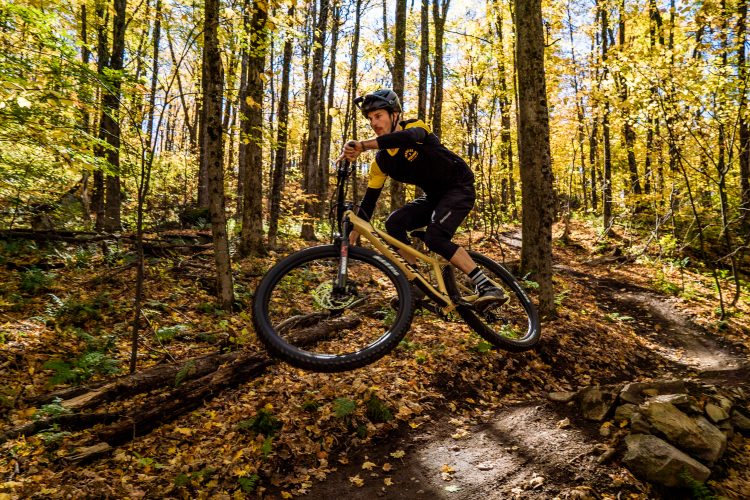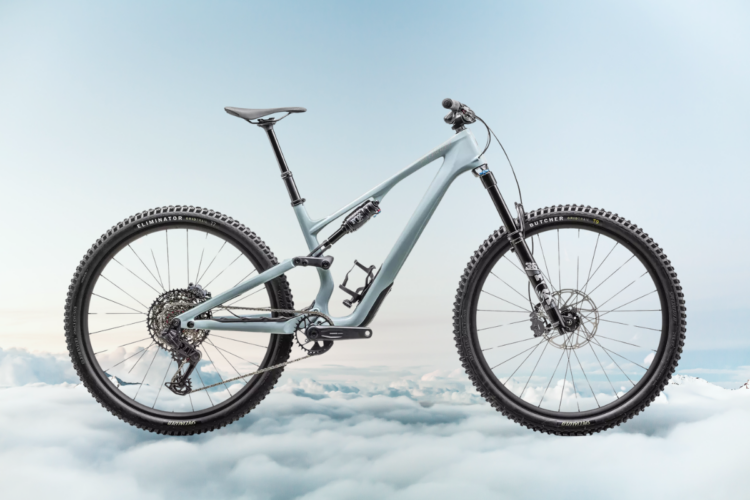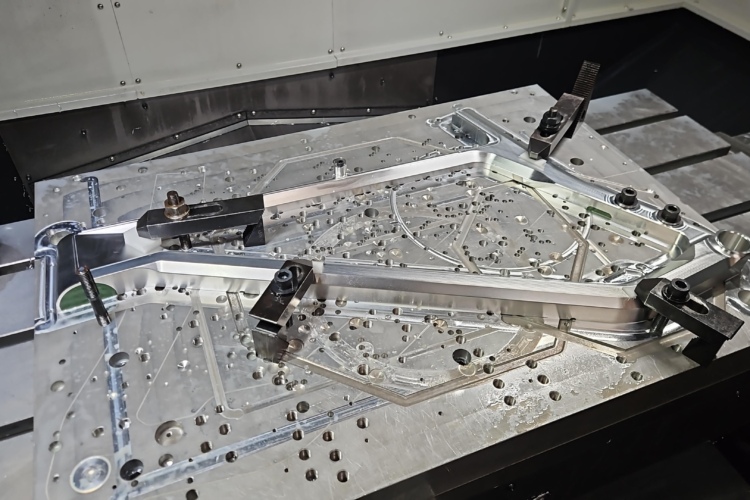
With so many brands already squeezing shoulders for space in the bike industry, the Viathon debut was one that mountain bikers least expected. To start, the new brand only rolled out one mountain bike, called the M1. The other two options included a road bike, the R1, and a gravel bike, the G1. At the bottom of it, most of us weren’t sure what to think about the Walmart stigma attached to Viathon.
The M1 is a conservative hardtail, with little edge to it, although there’s plenty of class. Its full carbon shines with a great colorway, comes with premium SRAM components, a modern build kit, internal cable routing, and good tires – something you’ll never see in the double-decker bike Walmart bike aisle stuffed between ammunition and car tires.

The Walmart association is a tough one to shake. Many of our parents bought our first bikes for us from the big box store when we were little. We rode them for years, only to come to the conclusion that despite the flame graphics down the side of the tubing, that they are in fact not cool, and that Walmart is evil and swallows small businesses by the mouthful.
Then, descendants from the Walton family poured tens of millions of dollars into developing one of the hottest mountain bike destinations in the country and opened up their private property near Aspen, CO to build new trails which they opened for the public to ride. It’s conflicting to say the least.
Walmart’s investment into bicycling continued as they have developed Viathon, but now that this horse is lying on the ground, dead and lumpy, let’s talk about the bike.

Viathon Bikes are currently sold on the Viathon website (Update: you can now purchase Viathon Bikes here at Walmart.com), direct to consumer with a frameset starting at $2,000, a SRAM GX Eagle build sold at $2,400, an XO1 build at $3,500, and an XX1 Eagle build for $6,000. Yeah, those are definitely not “everyday low prices.”
On a recent trip to Sun Valley, Idaho for a media event and the town’s first Outerbike, which included a Viathon demo, I took the M1 for a spin on a local trail in Sun Valley.

I ran my eyes over the Viathon more intensely than I do other test bikes. Internal cable routing? Check. Chain slap guard? Check. Down tube protection? Yep. A SRAM XX1 Eagle 12-speed drivetrain? Uh huh. Dropper post? Yeah, a RockShox Reverb. What about the wheel setup? Stan’s wheels and Continental tubeless tires. “Wow, not bad,” I thought. Even better, the M1’s weight was in the low 20’s.

A group of us rode the M1s over to the Adam’s Gulch trails, about fifteen minutes away from the venue. I noticed the responsiveness and lack of mush in the rear end immediately. It’d been a few years since I’d ridden a hardtail. I could tell it would be pretty sweet climbing, and sweet it was.
The stiff, carbon frame means an efficient power transfer from the pedals to the rear wheel, and the Continental CrossKing tires spun easily through the pebble on hardpack trails. I spun up a steep climb, enjoying the grind and the full efficiency of the hardtail.

The Viathon’s geometry is square, and XC-minded, and puts plenty of rider weight toward the front end, while the 70mm stem allows riders to get even more weight on the front tire to keep it tracking uphill. The long stem also opens up the 417mm of reach on the frame. Slow speed handling and agility also feel great on the M1, making it easy to change the direction immediately. Don’t want to pedal over the protruding rock in the trail? The M1 snaps left or right in a millisecond to detour.

For the smooth, Sun Valley trails that shot us into the Idaho backcountry and opened up views of green mountains splotched with yellow wildflowers, I felt like pedaling the lightweight M1 further and further. But, with another ride planned in an hour or two, it was time to turn around and head back to the venue.
So we all filed back in line and picked up speed toward the trailhead. Once I started descending on the M1, I realized exactly what the bike was meant for, whether that was Viathon’s intent or not. That snappy handling doesn’t disappear when the Viathon flows with gravity. The 69.5-deg. head angle is steep by almost any margin these days, and now, might be just north of the XC ballpark.

Several full-suspension cross-country bikes that I have been riding lately, like the Pivot Mach 4 SL, Salsa Spearfish, and Fezzari Signal Peak have sub 68-degree head angles. The Mach 4 SL World Cup build actually has a 68.5-degree head angle. Chloe Woodruff won the Nove Mesto na Morave short track World Cup round on the bike.
What I’m getting at, is that new age XC bikes have relaxed their geometry to make them much more comfortable to descend on, while the slacker head angles haven’t subtracted the bike’s climbing ability. Viathon though, stuck with tried and true XC geometry and you can feel it.
I had a really hard time feeling comfortable descending on the Viathon M1 because the steering was so responsive, and the bike so forward, due to the long stem and steep head angle. Steering on the bike happens mostly with your hands, rather than putting your hips into the corners, which feels a little old-school.

Chain slap was pretty noisy because the M1’s guard doesn’t have any sound-damping qualities, it’s meant mostly to protect the paint and is thin. The internal cable routing also rattles a lot and brings more noise into the rider’s ears. When I stopped to examine the cable routing, and double checked across their other bikes, all of the routing rattles and feels pretty loose.

The build kit was super solid, however. The RockShox SID ramps up nicely and is a great lightweight fork. The SRAM Level Ultimate brakes offer plenty of power for the bike, and the Stan’s Crest wheels, with a 23mm internal width, feel like the perfect match for the bike, as they should since the Viathon feels like a cross-country hardtail.
And while the M1 wasn’t the most enjoyable bike I’ve ridden lately, I wouldn’t say it is bad at all. Buyers should just be aware that the M1 rides like an XC hardtail, despite the fact that Viathon says it may appeal to a wider base. To me, Viathon’s messaging presents a conflict.

Jeff Barber peeked at the M1 at the debut at Sea Otter. Jeff surmised that while Viathon markets the M1 towards a broader rider base who want a more affordable carbon trail bike, the geometry reflects that of a cross-country race hardtail. I hadn’t read that since April, and forgot the context of it until it was time to write this review. I read it again and I agree with his take after riding the M1.
The M1 is very light, looks great, and is an excellent climber, but the geometry feels too racy to appeal to non-racers.

Although aluminum, and with a lesser parts kit, the Commencal Meta HT AM sells for $2,100 with geometry that is on the complete opposite end of the spectrum for a hardtail, and likely much more comfortable to descend on.
For $2,400, Guerrilla Gravity also sells a trail-worthy hardtail, made of steel, and with an NX Eagle drivetrain, and more relaxed geometry.
For $3,000, Diamondback makes a carbon Sync’r hardtail with a GX Eagle drivetrain, again with relaxed, enduro territory geometry.
[see_also id=’269400′]
Now, looking through the prices and the weights of the three hardtails mentioned directly above, Viathon has the edge on the price and build kit included, and the weight, but the other three seem more comfortable for the everyday trail rider, the same rider Viathon says they are after.
I could see Viathon having a lot of success with the M1 if they marketed the GX build as an entry-level cross-country hardtail, for young racers who want something they can smash XC laps on and take to weekend races. The M1 is certainly competitive in that category. Or, for someone who wants to save some dough in comparison to buying an S-Works hardtail, or something similar.
Final word

I only put about fifteen miles on the Viathon, but there was a lot I could tell from my time with it. Personally, I don’t feel that it’s the most comfortable trail bike for the everyday rider. I would look at other brands if I was going to purchase a hardtail for everyday, non-competitive trail riding. If however I was looking for a hardtail that I could pound out training miles on, take to XC races, and save a little bit of money (hi NICA racers), the Viathon would be at the top of my list.
⭐️Find the Viathon prices and models at Walmart.com










17 Comments
Jul 22, 2019
Jul 25, 2019
Jul 22, 2019
Jul 29, 2019
Jul 22, 2019
Thanks for the write-up. Still not really sure what to make of the Viathon bike line. It's kind of like Canyon but with a completely absent brand story; but arguably competitive market-level quality and design / spec. Maybe they just need more time in the market to develop a real following and dynamic story.
Speaking directly to assessing the M1, I think taking a deep dive / test ride on the GX build would help support Viathon's efforts in marketing this specific bike better. I think the M1 is much more suited to the entry level rider who's just getting into mountain biking or like you said, a heavy-leaning XC rider who's more interested in speed and climbing than technical descents. If I was looking for an X01 or XX1 build hardtail, I would definitely be looking elsewhere; there's just so many better options out there regarding purely versatile and top-quality hardtails.
Jul 23, 2019
Jul 23, 2019
Jul 22, 2019
But I agree, this bike is held back by outdated geometry.
Do you think you would have been happier if you threw a leg over the large sized bike with a shorter, 50mm stem?
The frame only price is kind of crazy...
The Ibis DV9 has way better geometry for everyday trail riding and frames start at $1,200.
Jul 24, 2019
Jul 23, 2019
The Scott Scale says right in its description from Scott; “Geometry inspired by racing at the highest level”.
This bike and the Scott have XC racing geometry. Not what I would be putting on a bike that’s intended for general purpose trail riding. Something that can climb and descend just as comfortably and confidently, nice and stable.
You’re also just looking at the HTA. The reach is also super short with longer stems to compensate. Crest wheels on a “modern” bike that top out on a 2.25 wide tire width (from Stans), you don’t get a dropper till you’re in the $6k bike...
At least the lower spec bikes are specced with Arch wheels.
As the author was eluding to, it’s not a bad bike but it does miss its intended audience...
Jul 23, 2019
Jul 22, 2019
Jul 25, 2019
BTW...the sentence "Walmart’s investment into bicycling continued as they have developed Viathon, but now that this horse is lying on the ground, dead and lumpy, let’s talk about the bike." is extremely hard to comprehend what you are trying to communicate.
Jul 25, 2019
Thanks for the feedback. Anything else?
Jul 25, 2019
"At Viathon, we believe that great bikes make riding more fun. And when you have fun, you ride more."
"...You’ve always wanted to master every trail. Now you can."
I hear in this a pitch to new-to-cycling buyers - "Be the rider (healthier person) you wish to be."
The geometry favors XC racing, but will feel zippy to any folks seeking efficiency at lower speeds. This might be the bike we start seeing strapped to the backs of RVs.
Jul 25, 2019
Jul 25, 2019
"Viathon Bikes are currently sold on the Viathon website, direct to consumer with a frameset starting at $2,000, a SRAM GX Eagle build sold at $2,400, an XO1 build at $3,500, and an XX1 Eagle build for $6,000." As stated, they are not sold through Wal-Mart.